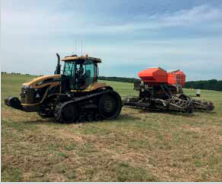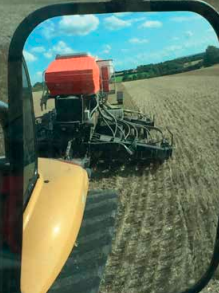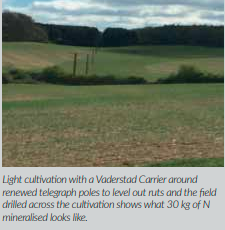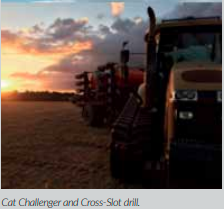Wheatsheaf Farming Company (WFC) farms around 700 Hectares of grade 3 land in Hampshire for 3 landowners. 2 of the landowners also own WFC as a method of farming their land more cost effectively. David Miller, their farm manager, describes details of their move from conventional to no-till farming.

I have worked in farming full time since 1975 and have progressed through the farming fashions that have presented themselves through the next 35 years. As such this branded me as a “conventional” farmer. We moved from a low input, low output system to the new-fangled German Schleswig-Holstein method of wheat production. This involved increased nitrogen applications matched by increased fungicide applications to produce higher yields. ICI promoted a system of direct drilling which used liberal doses of Paraquat and a Bettinson 3D direct drill with disc openers. We tried deep ploughing, shallow ploughing, square ploughing, deep cultivating, shallow cultivating and scratch tillage.
We changed the crops we grew to match the latest fashion. Oilseed Rape came into the rotation with fields of Jet Neuf and Bienvenue. Eight feet tall and not a CSFB in sight. We didn’t own a quad bike or use slug pellets. Sugar beet were dropped to help us concentrate on our goal of becoming paid up members of the illustrious wheat 10 tonne club.

Straw was a nuisance to all noninversion cultivation so a straw spreader was fitted to the back of the New Holland 1540 combine to spread the straw the full 13 feet width of the header so that a comprehensive all over burn would be achieved. When burning was banned we started dealing with the swaths of straw with a tractor mounted chopper, hours sat in a Ford 5000 with no rear window and a crash helmet for safety against flying stones. The combine was eventually traded in for one with the chopper already fitted. The chopped straw was sprayed with a “Stubble Digester” to help break it down before it was ploughed with the hope that it would not be ploughed back out again the next year.
Drill fashions were also followed, from a Massey 30 in the early days to Vaderstad Rapide more recently but including Amazone and Kuhn combinations and a couple of Accord air drills also.
The advances in yields in the first 20 years saw the rise from 2T/acre to 4T/ acre. Over the next 15 years it has not been so good with only a very marginal increase. This is despite advances in the varieties we grow as well as better plant protection products, better fertilizers, GPS and sensor application techniques and basically anything big business could convince farmers to buy with the promise of improved yield/ income. Journals, Conferences, Field days and any other method of knowledge transfer afforded us with a greater understanding of every aspect of crop production EXCEPT the resource we totally rely on, SOIL.
In 2010 our emphasis changed to looking at how we could help the soil function better. Cover crops were trialled and gave visible if not scientific results. The first was a crop of Crimson clover sown on half a field which gave a visible line in the next 2 crops. Next was beans and vetch over 2 fields which gave similar visible results quantified with an N-tester which showed a greater amount of N in the leaf of the following crop. By 2014 all spring cropped ground was cover cropped with a diverse 6 way mix.

A lesson learned early on was that this is a long-term project and not a yearly spend for a positive financial return in the same year. The next step was to consider direct drilling as the logic of not disturbing the soil structure, root channels, worms and worm burrows as well as weed seeds was confirmed in many articles written about boosting soil organisms. We had now also stopped straw removal.
We stumbled through the next few years adjusting our system from theoretical knowledge gained from principles, ideas, guidelines and gut feelings. This has now given us experience, results, successes and failures with which we are better armed to base future decisions as to how we evolve the system. We have gone from conventional farmers to now practicing Conservation Agriculture (CA). According to a UN FAO definition in 2007 that states,
CA is a concept for resource saving agricultural crop production that strives to achieve acceptable profits together with high and sustained production levels while concurrently conserving the environment. Based FEATURE Wheatsheaf Farming Company (WFC) farms around 700 Hectares of grade 3 land in Hampshire for 3 landowners. 2 of the landowners also own WFC as a method of farming their land more cost effectively. David Miller, their farm manager, describes details of their move from conventional to no-till farming. FEATURED FARMER DAVID MILLER DIRECT DRILLER MAGAZINE www.directdriller.co.uk 9 on the 3 principals of minimal soil disturbance, permanent organic soil cover and diverse crop rotations and interactions These are to give the benefits of increased organic matter, increased water conservation and improved soil structure.
Our present rotation is based around nearly 50% spring cropping and includes Winter Wheat (milling and feed), Winter Barley (feed), Winter Oilseed rape (with a companion crop), Winter Beans, Spring Barley (seed crops), Spring Linseed (yellow for human consumption). We are also trying some Spelt wheat and also growing Lupins and buckwheat for our own cover crop seed.
Cover crop mixes have continued to evolve and 2 principals are adhered to, no cereals in the pre spring barley mix and no brassicas in any mix. In the very wet first years the oil radish and tillage radish caused massive and costly slug problems as well as not having any Mychorrhizal association. I am confident these principals will change as we progress further into CA. Huge quantities of above ground biomass are less important, at the moment, than the amount of diverse root architecture. Current species used in covers are Lupins, Vetch, Beans, Phacelia, Buckwheat, Berseem Clover, Linseed and Camelina. Average cost per hectare is now around the £20 mark. All seed is bought as straights and mixed on farm. Companion cropping for oilseed rape this year is a mix of Crimson and berseem clover and one field has inter row Beans. Cost of both scenarios is about £15/ha. A wheat field with a companion crop of volunteer Beans will have several different trials on it based on fewer inputs of fertiliser and fungicides.

Potash has historically been spread variable rate according to soil analysis maps but this stopped 5 years ago and no bagged potash has been applied since. Last year’s analysis maps have shown no great deficiencies and, in some cases, increases especially where more cover crops have been grown. Phosphate is applied under an EA derogation as DAP to all winter cereals at a yearly decreasing rate and we are currently placing 50kg of product per hectare. Nitrogen mineralisation through cultivation is said to release about 30 kg of N and in the early years of transition to No-till this lack of available N at drilling shows up as backward and sickly looking emerging crops. As the soils improve this application is actually detrimental to soil organisms so it is a commercial balance between growing a viable crop and improving the soil. Spring crops receive a DAP and enhanced Urea blend which supplies some available N as well as some slow release N.

The new system has had an effect on fixed costs with reductions in machinery as well as labour. Diesel has been calculated as the total diesel used over 12 months divided by the total hectares cropped. 10 years ago this figure was around 85 lts/ha and calculated for 2018 it has fallen to 58 lts/ha. A 30% drop in fuel usage. CO2 release has been cut by 60% through cutting out cultivation, using less diesel and less nitrogen fertiliser.
Our system for establishment is to stubble rake after the combine and maybe again before drilling. This is mostly as cultural slug control by disrupting slug nests and eggs. This should become less necessary as the soil biology becomes more in balance. Drilling is done with the Cross-Slot drill which applies the fertiliser beside the seed and also a couple of kgs of Ferric Phosphate slug pellets. Fields are rolled post drilling, not really for consolidation but more for the flints that which may be sticking up.

We are now 5 years fully into a longterm system that has been embarked upon with the vision of being able to farm more in tune with the environment, with less inorganic inputs, producing healthier food from healthier crops and ultimately having a more resilient business and regenerated soil.
This is a personal account with thoughts based on my journey through over 44 years in arable farming both in Essex and Hampshire. The whole experience has now increased my thirst for knowledge about soil health and its direct impact on plant health. Books by such experts as Gabe Brown, Jon Stika, David Montgomery and the visionary from the 1940’s , Edward Faulkner with his books, Ploughmans Folly and Ploughing in Prejudices have all been read. This has managed to either, confuse me further or helped make sense of some of the practices we have embarked upon. Conferences with speakers such as Gary Zimmer, Dr Christine Jones and Joel Williams have been eagerly attended with multiple pages of notes taken. This then led to many hours of trying to understand how the principals contained in their presentations could be put into practice within our transition from a 40 year chemical based farming system to the brave new world of Conservation Agriculture.
